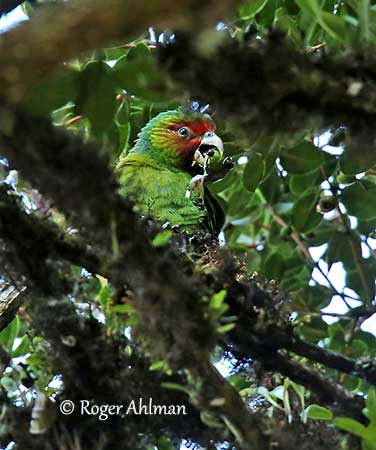
Male and female are similar.
The juvenile is duller. The red colour is duller on face and bend of the wing to lesser wing-coverts.
RANGE:
The Red-Faced Parrot is confined to eastern Andes of S Ecuador and adjacent NW Peru. It can be seen from Cajamarca in N Peru, and N to northern Cañar and western Morona-Santiago in S Ecuador.
HABITAT:
The Red-Faced Parrot frequents the wet, mossy upper montane forest, but also open woodlands or stunted forest adjacent to páramo.
It is tolerant to some habitat disturbance and can be observed in remnant patches of degraded forest through grazing areas. It also frequents secondary growth.
The species occurs between 2,400 and 3,500 metres of elevation.
CALLS AND SONGS: SOUNDS BY XENO-CANTO
The Red-Faced Parrot gives a rapid series of squawk-like “chek” of variable pitch prior to take off. When in flight, it gives a series of “che-ek…che-ek” notes, higher-pitched on the second note “ek”.
When the bird is perched at roost site, it produces a rapid, high-pitched sequence of “eek” followed by throaty “thrut” and then by three lower “eek”, another “thrut” and “eek” described as “eek-eek…thrut…eek”. This series is used as contact call. Other calls are uttered by foraging or perched parrots “eek…eek-eek”.
The juvenile produces a variable call “chur-ch-chur… chur-ch-chur…eek…ek-er…eek-eek…eek-ha-ha-a…ek-er…”
This series is accompanied by strong wing-beating before the young was fed by an adult.
BEHAVIOUR IN THE WILD:
The Red-Faced Parrot feeds on fruits (Miconia), berries (Viburnum), shoots (Weinmannia), flowers, seeds, pods and parts of trees (Ericaceous).
It is generally quiet and secretive while foraging within the crowns of the trees.
It is usually seen alone, in pairs or in small groups. This species is gregarious and is often observed in flocks of up to 20 birds flying over the forest.
The Red-Faced Parrot nests in tree hole and both parents share most of nesting duties. When the nest is a natural cavity, the female alone arranges it.
They are monogamous. Mutual preening, billing and courtship feeding are probably part of the courtship displays prior to copulation.
The species is resident and only performs some local movements related to food availability.
The flight is swift and direct with rapid wingbeats.
REPRODUCTION OF THIS SPECIES:
The breeding season takes place between October and January, during the dry season.
The Red-Faced Parrot nests in tree cavities.
From an observation from October 1994 to January 1995 in Ecuador, a nest was in a cavity, a hole in a Lauraceae tree, placed at 17-18 metres above the ground. The pair was around the nest and one of the birds was feeding the other with regurgitated food. They were perched on a branch, about 20 metres from the nest.
The entrance of the cavity was 77 cm long by 9 cm wide and 45 cm depth. Two creamy-white eggs were laid on the nest-floor, a flat base with some dust and a few wing-blown leaves. Usually, parrots do not add nesting material.
Two chicks were observed in early December. Later, in early January, both chicks had green feathers and some red feathers on crown and throat. The young fledged by late January and were seen close to the nest-tree.
PROTECTION / THREATS / STATUS:
The Red-Faced Parrot is threatened by fragmentation, degradation and destruction of the habitat, through slash-and-burn conversion for agriculture. Logging, burning and grazing involve the degradation of the forest.
The population is estimated to number 2,500/9,999 mature individuals, roughly equivalent to 3,750/14,999 individuals.
This species is rare to uncommon or local throughout the range, and the population is rapidly declining.
The Red-Faced Parrot is currently listed as Vulnerable.
Fr: Caïque de Salvin
Ang: Red-faced Parrot
All: Salvinpapagei
Esp: Lorito Ecuatoriano
Ita: Pappagallo facciarossa
Nd: Vuuroogandespapegaai
Sd: rödmaskpapegoja
Photographer:
Roger Ahlman
Pbase Galleries Peru and Ecuador
Text by Nicole Bouglouan
Sources:
HANDBOOK OF THE BIRDS OF THE WORLD vol 4 by Josep del Hoyo-Andrew Elliott-Jordi Sargatal - Lynx Edicions - ISBN: 8487334229
PARROTS OF THE WORLD – An Identification Guide – by Joseph M. Forshaw – Princeton University Press – ISBN 0691092516
BIRDS OF PERU by Thomas S. Schulenberg, Douglas F. Stotz, Daniel F. Lane, John P. O’Neill, Theodore A. Parker III – Princeton University Press 2007– ISBN: 978-0-691-13023-1
Neotropical Birds – Cornell Lab of Ornithology
Wikipedia, the free encyclopaedia
First nest record of Red-faced Parrot Hapalopsittaca pyrrhops
Vocalizations of the endangered Red-faced Parrot Hapalopsittaca pyrrhops in southern Ecuador
Red-faced Parrot
Hapalopsittaca pyrrhops
Psittaciformes Order – Psittacidae Family
INTRODUCTION:
The Red-Faced Parrot is found in Ecuador and Peru where it has recently been observed at some new localities.
It frequents wet, upper montane cloud forest and shrubby growth close to páramo. It typically feeds on fruits, berries, flowers and seeds. It nests in cavities, often tree holes.
The Red-Faced Parrot is rare to uncommon and local, and the population is declining due to habitat destruction, fragmentation and degradation of forest.
It is currently classified as Vulnerable.
DESCRIPTION OF THE BIRD:
Biometrics:
Length: 22-23 cm
The Red-Faced Parrot has green plumage overall, but it English name describes very well the head pattern.
Forecrown, lores, cheeks, supercilium and chin are red. Ear-coverts and hind cheeks are green with fine greenish-yellow streaks. The crown is green washed blue.
There is a red shoulder patch and some red wing feathers visible on closed wing. Primary and part of secondary flight-feathers are blue. The graduated tail is green with violet-blue tip.
On the underparts, some belly feathers are tipped red, but this red patch varies in some individuals.
The bill is pale, horn-coloured, with bluish-grey base of lower mandible. The eyes are greenish-yellow, surrounded by bluish-grey bare skin forming an eyering. Legs and feet are dark grey.
